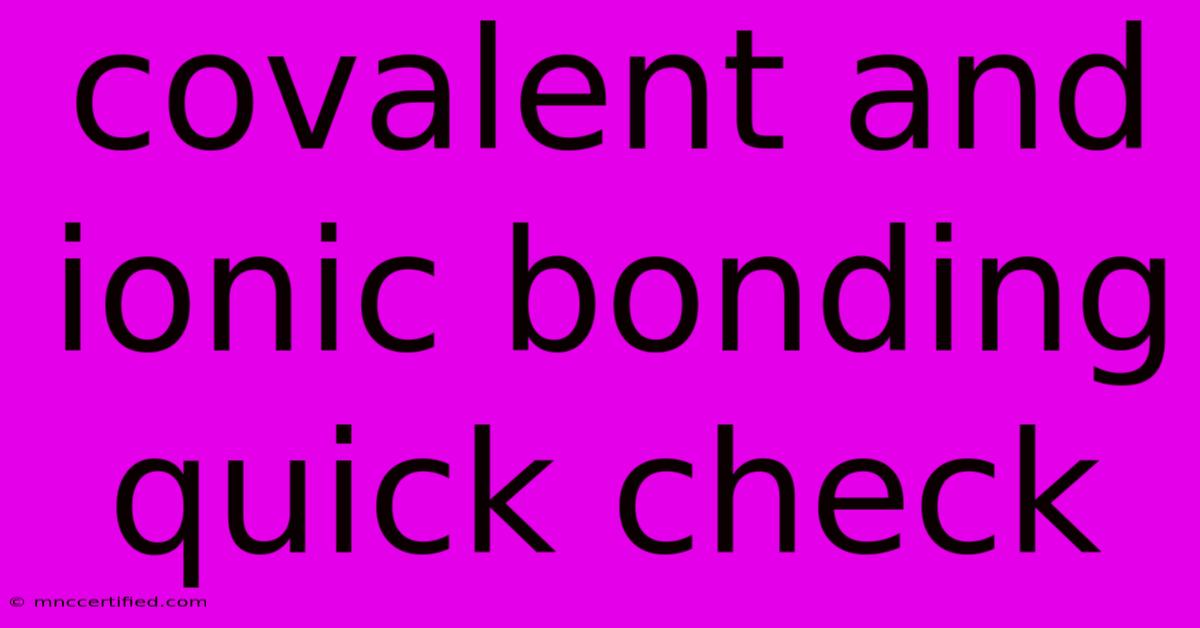Covalent And Ionic Bonding Quick Check

Table of Contents
Demystifying Covalent and Ionic Bonding: A Quick Check
Chemistry can be a challenging subject, but understanding the fundamentals of bonding is crucial. Two key types of bonding, covalent bonding and ionic bonding, are the building blocks of countless molecules and compounds. This quick check will help you solidify your understanding of these concepts:
Covalent Bonding: Sharing is Caring
Imagine two atoms, each needing an extra electron to achieve a stable outer shell. They can achieve this stability by sharing electrons! This sharing forms a covalent bond, a strong attraction that holds the atoms together.
Here's what you need to know about covalent bonds:
- Sharing electrons: Both atoms contribute electrons to form shared pairs.
- Nonmetal-nonmetal: Covalent bonds typically occur between nonmetal elements.
- Strong attraction: Shared electrons create a strong force, holding the atoms together.
- Molecules: Covalent bonds form molecules, discrete units of atoms.
- Examples: Water (H₂O), carbon dioxide (CO₂), methane (CH₄).
Ionic Bonding: Give and Take
Instead of sharing, imagine one atom giving an electron to another, creating oppositely charged ions. These ions, attracted to each other, form an ionic bond.
Key characteristics of ionic bonding:
- Transfer of electrons: One atom loses electrons, becoming a positively charged ion (cation). The other atom gains electrons, becoming a negatively charged ion (anion).
- Metal-nonmetal: Ionic bonds typically occur between metals and nonmetals.
- Electrostatic attraction: The opposite charges of the ions create a strong electrostatic force, holding them together.
- Ionic compounds: Ionic bonds form ionic compounds, large structures containing many ions.
- Examples: Sodium chloride (NaCl), calcium oxide (CaO), magnesium fluoride (MgF₂).
Quick Check Questions
- What is the primary difference between covalent and ionic bonding?
- What type of elements typically form covalent bonds?
- What type of elements typically form ionic bonds?
- Describe the forces holding atoms together in each type of bond.
- Give an example of a molecule formed by covalent bonding.
- Give an example of a compound formed by ionic bonding.
Understanding the Difference
Remember, covalent bonds are about sharing electrons to achieve stability, while ionic bonds involve the transfer of electrons, leading to electrostatic attraction. This fundamental difference affects the properties of the resulting compounds.
Dive Deeper!
This quick check is just the start. To further solidify your understanding, explore the following resources:
- Lewis Dot Structures: Visualize how atoms share electrons in covalent bonds.
- Electronegativity: Understand how electronegativity differences influence the type of bond formed.
- Polar Covalent Bonds: Learn about bonds where electrons are shared unevenly.
Mastering the concepts of covalent and ionic bonding is a crucial step towards a deeper understanding of chemistry!

Thank you for visiting our website wich cover about Covalent And Ionic Bonding Quick Check. We hope the information provided has been useful to you. Feel free to contact us if you have any questions or need further assistance. See you next time and dont miss to bookmark.
Featured Posts
-
India Crushes South Africa In T20 International
Nov 09, 2024
-
Bhad Bhabie Explains Weight Loss Cites Medication
Nov 09, 2024
-
Lord Mayors Show Monday Vs Saturday History
Nov 09, 2024
-
What Does Toa Mean In Dental Insurance
Nov 09, 2024
-
Hearts Lose To Heidenheim In Spfl Game
Nov 09, 2024